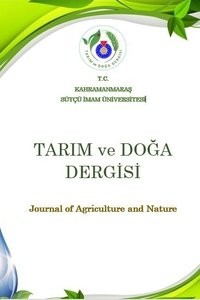Yavru Koi Sazan (Cyprinus carpio) Diyetlerine Katılan Keçiboynuzu (Ceratonia siliqua) Tohumunun Besleme Değeri
Çalışmada rasyonlara farklı oranlarda keçiboynuzu tohumu ilave edilerek koi sazanı (Cyprinus carpio) balıklarının 60 günlük deneme boyunca büyüme parametreleri, yem dönüşüm oranı, canlı ağırlık artışı, kondisyon faktörü üzerine etkileri araştırılmıştır. Keçiboynuzu (Ceratonia siliqua) tohumu diyetlere %0, 10, 20, 30, 40 oranlarında katılmıştır (K0, K1, K2, K3, K4). Denemede büyüme parametreleri bakımından K1 ve K2 diyet grupları ile K0 grubu arasında fark saptanmazken (P>0.05), yüksek oranda (%20 den fazla) keçiboynuzu tohumu katılan K3 ve K4 diyet grupları K0 grubuna göre düşük bulunmuştur (P˂ 0.05). Sonuç olarak keçiboynuzu tohumu koi sazan yemlerinde alternatif yem katkı maddesi potansiyeline sahiptir ve herhangi bir olumsuz etkisi olmaksızın rasyonlara %20’ye kadar katılabilir.
Anahtar Kelimeler:
Keçiboynuzu, Koi sazanı, Cyprinus carpio, Büyüme, Balık unu
Nutritive Value of Carob Kernel Flour (Ceratonia siliqua) Seed as Ingredient in Diet for Koi Carp (Cyprinus carpio) Fingerlings
In the study different proportions of carob seeds by adding in diets. Koi carp (Cyprinus carpio) fish 60- day trial for growth parameters, feed conversion of ratio, live weight gain, condition factor upon were investigated. Carob kernel flour (Ceratonia siliqua) seeds to diets containing 0%, 10, 20, 30, 40 participated (K0, K1, K2, K3, K4) respectively. There were no significant differences (P>0.05) among fish fed diets K0, K1 and K2 in terms of growth parameters. Fish fed diets containing higher levels (>20%) K3 and K4 had significantly lower than K0 diets. Results show that carob kernel flour seed has potential as an alternative feed ingredient in diets for fingerling koi carp (Cyprinus carpio) with no adverse effect. Carob kernel flour seed can be used up to 20%.
Keywords:
Carob kernel flour, koi carp, Cyprinus carpio, the growth, fishmeal,
___
- Adebayo, O.T., Fagbenro, O.A., Jedege, T. 2004. Evaluation of Cassia Şsculata Meal As A Replacement for Soybean Meal in Practical Diets of Oreochromis niloticus Fingerlings. Aquaculture Nutr., 10: 99-104.
- AOAC, 1990. Oficial methods of analysis (15th ed.) official Association Washington DC, USA. Pp.69-88. analytical chemisits,
- Borlongan, I. G., Eusebio, P. S., Welsh, T. 2003. Potential of feed pea (Pisum sativum) meal as a protein source in practical diets for milkfish (Chanos chanos Forsskal). Aquaculture, 225: (1-4), 89-98.
- Büyükçapar, H.M., Kamalak, A. 2006. Raw and Heat treated Culban (Vicia peregrine) seed as Protein source for Mirror carp (Cyprinus carpio) fingerlings. South Afr. Journ. of Animal Science, 36(4):235-242.
- Büyükçapar, H.M., Mezdegi, İ., Kamalak, A. 2010. Nutritive Value of Narbon Bean (Vicia narbonensis) Seed as Ingredients in Practical Diet for Tilapia (Oreochromis niloticus) Fingerlings. J. Appl. Anim. Res., 37:253-256.
- Büyükçapar, H.M., Kamalak, A. 2010. Nutritive value of wild pea (Pisum elatius) seeds as dietary protein source Şngerlings. Bamidgeh, 62(4), 272-280. (Cyprinus of Aquaculture
- Büyükçapar, H.M. 2012. Growth performance and body composition in mirror carp (Cyprinus carpio) fed culban seed (Vicia peregrina) with different heat treatments. Kafkas Üniversitesi Veteriner Fakültesi Dergisi, 18 (3): 389-394.
- Chong, A. 2003. Assesment of soybean meal in diets for Discus (Symphysodon aequifasciata HECKEL) farming through a fish meal replacement study. Aquaculture Research, 34: 913-922.
- Grant, G. 1991. Toxic Substances in Crop Plants. The Royal Society of Chemistry, Thomas Graham House, Science Park, Cambridge Cb4 4wff, Cambridge, Pp. 49-67.
- NRC 1993. Nutrient Requirements Of Fish, National Research Council, 114 Pp. The National Academies Press, Washington.
- Oliviera N.M.A., Martinez, P., Galvan, C.R. 1998. The use of seed of the leguminous plant (Sesbania graniflora) as a partial replacement of this meal diets for tilapia (Oreochromis massambicus). Aquaculture 71:51-60.
- Overland, M., Storebakken, T., Penn, M., Kroghdel, A., Skrede, A. 2009. Pea concentrate substituting fish meal or soybean meal in diets for Atlantic Salmon (Salmo salar)-Effect on growth performance, nutrient digestibility, carcass composition, gut health and physical feed quality. Aquaculture, 288: 305- 311.
- Pfeffer, E., Kızgınger, S., Rodelhutscord, M. 1995. Influence of the proportion of poultry slaughter byproducts and of untreated or hydrothermically treated legume seeds inn diets for rainbow trout, (Oncorhynchus mykiss), (Walbaum), on apparent digestililities compounds. Aquaculture Nutr., 1:111-117. energy and organic
- Regost, C., Arzel, J., Kaushik, S.J. 1999. Partial or total replacement of fish meal by corn gluten meal in diet for turbot (Psetta maxima). Aquaculture, 180: 99- 117.
- Tacon, A.G.J. 1997. Fish Meal Replacers: Review of Antinutrients Within Oilseed and Pulses. A Limiting Factor for the Aqua Feed Green Revolution? In: Feeding tommorrow’s Fish. Eds. Tacon, A.G.J. and Basurco, B., Pp. 153-182. Cahiers Options Mediterraneennes. Mediterraneenne de Zaragoza, Spain. Instut Agronomique
- Ustaoğlu, S., Karayücel, İ., Alagil, F., Dernekbaşı, S., Yağcı, F. 2009. Evaluation of extruded chickpea, common bean and red lentil meals as protein source in diets for juvenile Rainbow trout (Oncorhynchus mykiss). Journal of Animal and Veterinary Advances, 8 (10): 2079-2086.
- Başlangıç: 1997
- Yayıncı: Kahramanmaraş Sütçü İmam Üniv.
